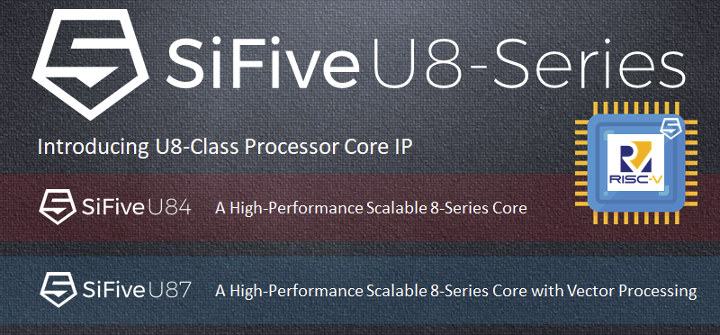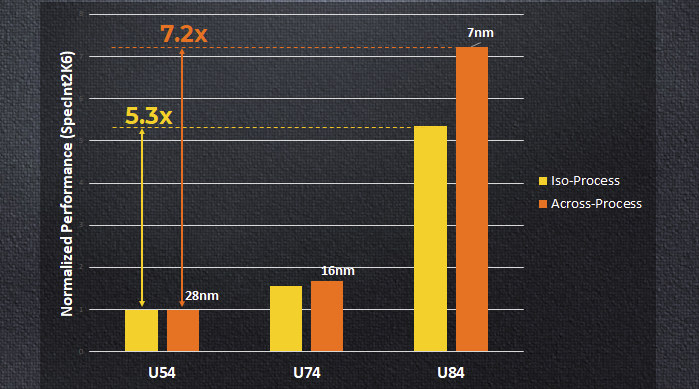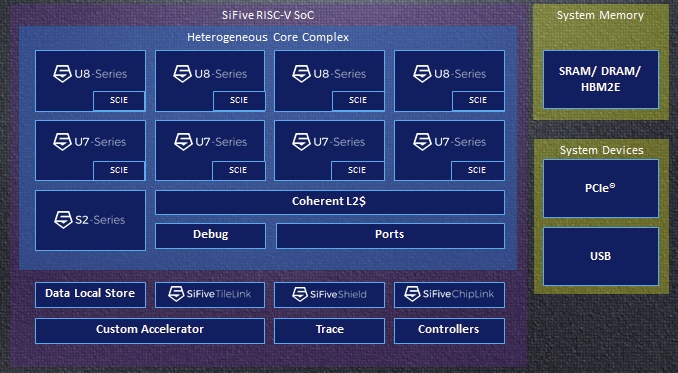Earlier this week, we wrote about SiFive Shield open security platform as the equivalent of Arm TrustZone security technology, but the company had had another important announcement this week with the introduction of SiFive U8-Series Out-of-Order (OoO) RISC-V Core IP with much higher performance than the company’s earlier U7-series core and competing with Arm Cortex A72 core.
At first, the company will offer two standard cores with SiFive U84 RISC-V core optimized for power efficiency and area efficiency, and the SiFive U87 RISC-V core with vector processing.
SiFive U84 Performance & Efficiency
We do not have much information about U87, but SiFive already published some interesting details about U84 cores.
SiFive U84 core offers about 3.1 times higher performance compared to their earlier U74 standard core thanks to a 2.3x increase in IPC combined with a 1.4x increase in maximum frequency. Compared to SiFive U54, U84 delivers 5.3x higher performance (isolated process) and when taking into account the improved process technology, the SiFive U84 standard core (7nm) is 7.2x faster than SiFive U54 (28nm).
Taking a quad-core SiFive U84 CPU with 2MB of L2 cache as an example, SiFive explains the chip would require 2.63mm2 area in 7nm process technology and achieve up to 2.6GHz clock speed. Compared to Arm Cortex-A72 @ 16nm, the SiFive U84 standard core is said to double the area efficiency, and improve performance/watt by 1.5 times.
SiFive did not provide direct performance comparison against Cortex-A72, and Arm certainly holds the lead in terms of performance with their newer Cortex-A76/A77 cores, but SiFive U84 is the first RISC-V core form the company to offer Cortex-A72 class performance.
SiFive U8-Series Scalability and Mix+Match Technology
While the U84 standard core is configured with a 12-stage pipeline and triple-issue capability, SiFive U8-Series Core IP will allow designers to configure options inside the Out-Of-Order design space hyperplane. The Core IP also features composable caches for real-time operation.
Similar to Arm big.LITTLE / DynamIQ, or Intel Foveros, SiFive Mix+Match technology will allow designers to combine various types of cores in a RISC-V SoC, for example mixing U8-Series cores for performance with U7-Series cores for power efficiency, and an S2-series core for real-time I/Os.
The new SiFive U8-Series Core IP is expected to be found in automotive, enterprise, and edge or endpoint AI markets. There’s no product page just yet, but you may still find a few more details in the announcement.

Jean-Luc started CNX Software in 2010 as a part-time endeavor, before quitting his job as a software engineering manager, and starting to write daily news, and reviews full time later in 2011.
Support CNX Software! Donate via cryptocurrencies, become a Patron on Patreon, or purchase goods on Amazon or Aliexpress







